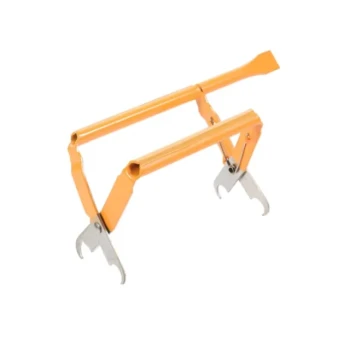To ensure structural integrity under demanding conditions, thicker comb foundations are reinforced with a variety of embedded materials. These reinforcements, which can include vertical wires, thin plastic sheets, metal edges, or nylon threads, are typically integrated directly into the foundation during manufacturing to provide a rigid internal skeleton.
The core purpose of reinforcing a comb foundation is not just to add strength, but to create a stable, reliable structure that prevents distortion under heat, supports the weight of honey, and withstands the immense forces of mechanical extraction.

The Purpose of Foundation Reinforcement
Understanding why reinforcement is critical provides context for the different methods used. Without a strong internal structure, a beeswax comb is surprisingly fragile.
Preventing Sag and Distortion
Beeswax softens in the high temperatures of a hive. Without support, a heavy comb can sag, stretch, or warp, leading to improper cell geometry and potential collapse.
Supporting Heavy Honey Loads
A single deep frame can hold over eight pounds of honey. Reinforcement provides the tensile strength needed to bear this load without breaking away from the frame.
Withstanding Extraction Forces
The centrifugal force applied during honey extraction is the most demanding test a comb will face. Reinforcement is essential to prevent the comb from blowing apart inside the extractor.
Types of Integrated Reinforcement
Most reinforced foundations come with support built directly into the wax. These methods are designed for convenience and reliability.
Vertically Embedded Wires
This is a classic method where strong, thin wires are embedded vertically within the wax sheet. These wires act like rebar in concrete, providing excellent support against sagging.
Thin Plastic Cores
Many modern foundations consist of a rigid, food-grade plastic sheet coated in a layer of beeswax. This offers the greatest durability and resistance to warping or breakage during extraction.
Metal Edges
Some foundations incorporate metal strips along the top or side edges. This strengthens the points where the foundation connects to the frame, preventing tear-out.
Nylon Threads
As an alternative to metal wire, some manufacturers embed vertical nylon threads. These offer similar tensile strength and support while being flexible and corrosion-resistant.
Supplemental Reinforcement Techniques
Beyond factory-installed supports, beekeepers can add their own reinforcement to frames, typically by wiring them horizontally.
Horizontal Cross-Wiring
Beekeepers often run thin-gauge wire (such as 28 or 30 gauge) horizontally across an empty frame before installing the foundation.
Embedding the Wires
Once the foundation is placed against these wires, a low-voltage electric current from a transformer is used to heat the wire slightly. This causes it to melt into the wax, securing the foundation firmly in place and adding significant horizontal support. A spur wheel embedder can also be used to press the wire in manually.
Understanding the Trade-offs
The choice of reinforcement involves balancing durability, convenience, and beekeeping philosophy. There is no single "best" option.
Durability vs. Natural Material
A plastic-core foundation is nearly indestructible but introduces a large amount of non-wax material into the hive. Wire-reinforced wax offers a compromise, providing good support with a more natural base.
Labor and Equipment
Using foundations with pre-embedded vertical wires is simple and requires no special tools. Adding your own horizontal cross-wires provides superior custom support but requires additional equipment and time.
Hive Management Impact
Highly durable plastic foundations allow for more aggressive hive management and faster extraction speeds. Pure wax foundations, even when wired, demand more careful handling.
Making the Right Choice for Your Goal
Select your foundation based on your operational priorities and management style.
- If your primary focus is maximum durability and high-speed extraction: Plastic-core foundations provide the rigidity needed to prevent any comb damage.
- If your primary focus is a balance of natural wax and reliable support: Wax foundations with embedded vertical wires are an excellent and widely used choice.
- If your primary focus is custom strength for specific conditions: Adding your own horizontal cross-wires to a foundation allows you to control the level of support.
By understanding these reinforcement methods, you can select a foundation that aligns perfectly with your beekeeping goals and ensures a strong, productive hive.
Summary Table:
| Reinforcement Method | Key Feature | Primary Benefit |
|---|---|---|
| Vertically Embedded Wires | Wires set within the wax | Excellent support against sagging |
| Thin Plastic Cores | Rigid plastic sheet coated in wax | Maximum durability for extraction |
| Metal Edges | Strips along top/side edges | Prevents tear-out from frame |
| Nylon Threads | Flexible, corrosion-resistant threads | Alternative to metal wire |
| Horizontal Cross-Wiring | Beekeeper-added wires across frame | Custom, superior tensile strength |
Equip your apiary with foundations built to last. HONESTBEE supplies high-quality, reinforced comb foundations and beekeeping equipment to commercial apiaries and distributors through our wholesale operations. Ensure your hives are productive and your combs withstand the rigors of honey extraction. Contact our team today to discuss your bulk supply needs.
Visual Guide

Related Products
- Professional Frame Preparation: The HONESTBEE Electric Wire Embedder
- Food Grade Plastic bee Foundation for Bee Frames
- Beeswax Foundation Sheets Beehive Foundation for Wholesale
- Manual Beeswax Comb Foundation Machine Wax Foundation Mill Embossing Machine
- Professional Pneumatic Wire Embedder for Beehive Frames
People Also Ask
- What feature of the frame wiring jig helps maintain wire tightness? The Essential Tensioner Explained
- What texture is embossed on the beeswax foundation machine? The Precise Worker Bee Cell Pattern for Hive Efficiency
- What should be done to the sidebars if wiring the frames? A Guide to Drilling Holes for Maximum Frame Strength
- How does the frame wiring jig assist in running horizontal wires through frames? Streamline Your Beekeeping Setup
- What is the final step in wiring a frame? Secure Lasting Tension for a Durable Hive


















